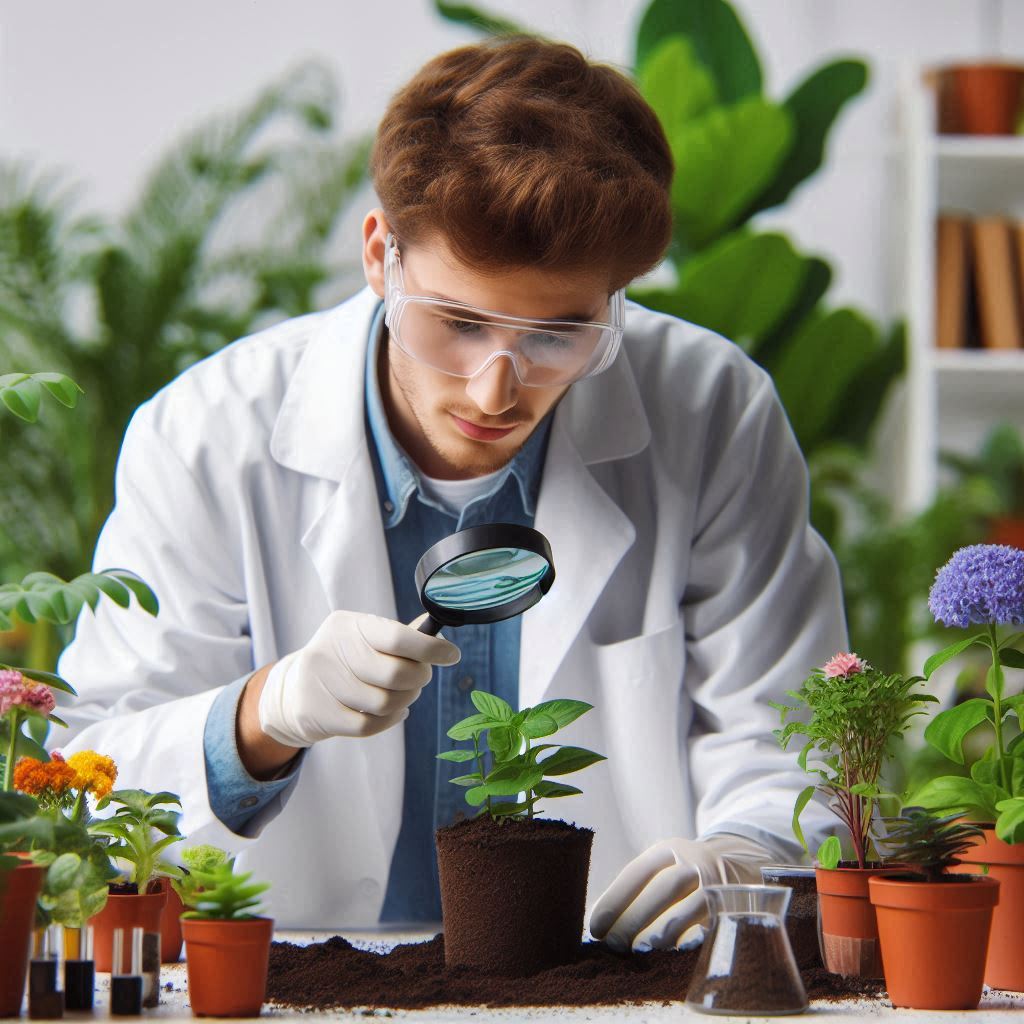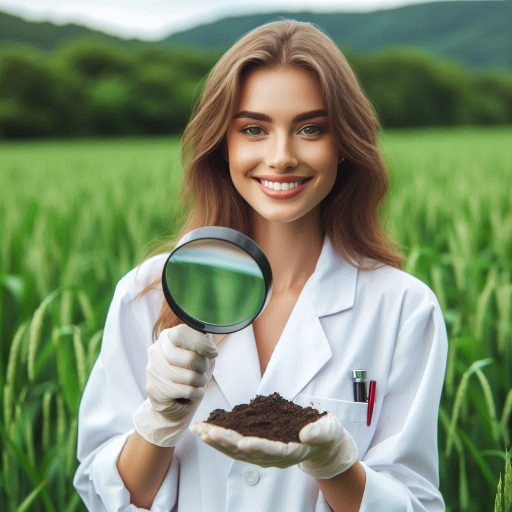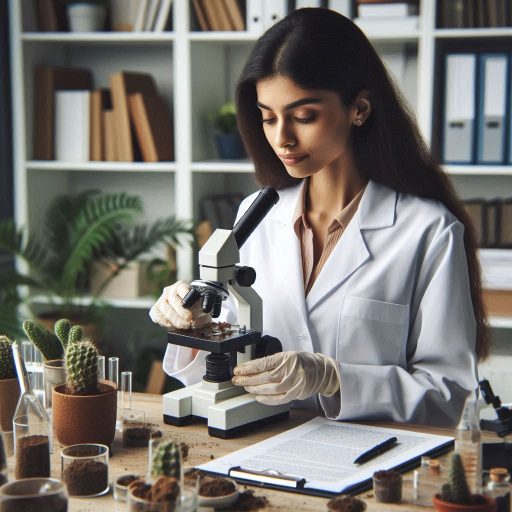Introduction
Soil scientists play a crucial role in supporting food security by studying, managing, and improving soil health and fertility.
Their expertise allows them to analyze soil composition, structure, and nutrient content, providing essential insights that help farmers optimize crop production.
By understanding the intricate interactions between soil properties and agricultural practices, soil scientists offer targeted solutions that enhance soil quality and promote sustainable farming methods.
The importance of soil quality in crop production cannot be overstated.
Healthy soil serves as the foundation for robust plant growth, influencing several factors critical to agricultural success.
Nutrient availability, water retention, and root development all rely heavily on soil quality.
When soil is rich in organic matter and microorganisms, it facilitates nutrient cycling and enhances the soil’s ability to retain moisture.
This is especially vital in regions prone to drought, where healthy soils can significantly impact crop resilience.
Moreover, quality soil supports diverse microbial communities that contribute to the breakdown of organic materials, releasing essential nutrients back into the soil.
These microorganisms play a critical role in enhancing soil structure, which improves aeration and root penetration.
In contrast, compromised soil quality can lead to reduced crop yields and lower nutritional value, threatening food security and the livelihoods of farmers around the world.
Conducting Soil Quality Assessments
Soil quality assessments are vital for enhancing food security.
Soil scientists play a crucial role in these assessments.
They analyze soil samples to determine nutrient levels and pH balance.
This process involves collecting soil samples from various depths and locations within a field.
How Soil Scientists Analyze Soil Samples to Determine Nutrient Levels and pH Balance
Once the samples are collected, scientists take them to a laboratory for analysis.
They assess key nutrients like nitrogen, phosphorus, and potassium.
They also measure soil pH, which affects nutrient availability to plants.
Soil scientists use techniques like colorimetry and spectrometry for precise analysis.
These analyses provide a comprehensive picture of soil health and composition.
Understanding soil composition helps farmers make informed decisions.
For instance, knowing nutrient levels guides farmers in choosing the right fertilizers.
Farmers can adjust their fertilization strategies based on the specific needs of their soil.
This tailored approach ensures optimal crop growth and minimizes waste.
How These Assessments Help Farmers Make Informed Decisions About Fertilization and Crop Selection
Soil scientists also evaluate organic matter content.
Organic matter plays a crucial role in improving soil structure and fertility.
Higher organic content enhances water retention and nutrient supply.
This assessment helps farmers adopt practices that increase organic matter, such as cover cropping and composting.
Furthermore, soil assessments help in crop selection.
Different crops have varying nutrient requirements and tolerances.
By understanding soil quality, farmers can select crops that thrive in their specific conditions.
This knowledge leads to higher yields and better resource utilization.
Regular soil assessments allow farmers to monitor changes over time.
They can track improvements or declines in soil health.
This information is vital for making long-term management decisions.
It helps in planning crop rotations and selecting appropriate cover crops.
Moreover, soil scientists recommend soil amendments based on their findings.
For instance, if a soil sample shows low phosphorus levels, they might suggest adding phosphate fertilizers.
This targeted intervention supports sustainable farming practices.
In addition, soil quality assessments contribute to broader agricultural strategies.
They support precision agriculture by providing data-driven insights.
Farmers can use this information to apply fertilizers and pesticides more efficiently.
This reduces environmental impacts and enhances sustainability.
Collaborating with local agricultural extension services, soil scientists share their findings with farmers.
They conduct workshops to educate farmers about soil health and its impact on food production.
This knowledge empowers farmers to adopt best practices.
In fact, soil quality assessments conducted by soil scientists are essential for food security.
They analyze nutrient levels and pH balance, guiding farmers in fertilization and crop selection.
By making informed decisions, farmers can improve yields and promote sustainable agriculture.
Read: Profiles in Success: Leading Chemists of the 21st Century in the US
Developing Sustainable Farming Practices
Soil scientists play a critical role in developing sustainable farming practices.
Their expertise helps farmers adopt methods that enhance soil health and protect the environment.
Two key practices they promote are conservation tillage and cover cropping.
The Role of Soil Scientists in Promoting Conservation Tillage and Cover Cropping
Soil scientists educate farmers about conservation tillage.
This method reduces soil disturbance during planting.
Instead of turning over the soil, farmers leave the previous crop residue on the surface.
This practice protects the soil structure and improves moisture retention.
Soil scientists conduct research to demonstrate the benefits of conservation tillage.
They provide data showing reduced fuel costs and labor requirements, making it an attractive option for farmers.
Cover cropping is another important practice promoted by soil scientists.
This involves planting specific crops, such as legumes or grasses, between main crop cycles.
These cover crops provide multiple benefits, including nitrogen fixation and organic matter addition.
Soil scientists conduct workshops to teach farmers about selecting the right cover crops.
They help farmers understand how cover crops can improve nutrient cycling and enhance biodiversity.
How These Practices Help Improve Soil Health and Reduce Erosion
Both conservation tillage and cover cropping significantly improve soil health.
Conservation tillage reduces soil erosion by minimizing the movement of soil particles.
The residue left on the surface acts as a protective barrier against wind and water erosion.
This protection is especially important on sloped fields, where erosion risk is higher.
Cover cropping enhances soil structure and fertility.
The roots of cover crops help bind the soil together, reducing erosion risk.
Additionally, when cover crops decompose, they add organic matter to the soil.
This organic matter improves soil structure, increases water infiltration, and enhances nutrient-holding capacity.
Soil scientists also highlight the importance of these practices in carbon sequestration.
By improving soil health, these practices help capture carbon from the atmosphere.
Healthier soils store more carbon, mitigating climate change impacts.
Furthermore, these sustainable practices promote biodiversity in agricultural systems.
Cover crops provide habitat for beneficial insects and soil organisms.
This diversity contributes to a more resilient farming system that can better withstand pests and diseases.
Soil scientists collaborate with agricultural extension services to spread awareness about these practices.
They conduct field trials to showcase the advantages of conservation tillage and cover cropping.
This hands-on approach allows farmers to see the benefits firsthand, encouraging adoption.
Soil scientists play a vital role in promoting sustainable farming practices like conservation tillage and cover cropping.
These practices improve soil health, reduce erosion, and enhance overall agricultural resilience.
By adopting these methods, farmers can ensure long-term productivity while protecting the environment.
Read: The Life and Times of a U.S. Physicist: A Day in Detail
Researching Innovative Agricultural Techniques
Soil scientists are at the forefront of researching innovative agricultural techniques.
They focus on improving crop resilience to climate change, which poses significant challenges to global food security.
This research is essential for developing strategies that help farmers adapt to changing environmental conditions.
Ongoing Research Projects Focused on Improving Crop Resilience to Climate Change
Many ongoing research projects target the development of climate-resilient crops.
Scientists are studying plant genetics to identify traits that enhance resilience, such as drought tolerance and pest resistance.
For example, researchers are using gene editing techniques like CRISPR to develop crops that can withstand extreme weather events.
These projects aim to create varieties that require less water and can thrive in higher temperatures.
Another area of research involves soil management practices that support resilient agriculture.
Scientists explore the effects of different soil amendments on crop performance under climate stress.
They study how organic matter, biochar, and compost can improve soil structure and fertility.
This research helps farmers select the right practices to maintain soil health even in adverse conditions.
Additionally, soil scientists investigate the impact of cover crops and crop rotation on resilience.
These practices improve soil health and enhance biodiversity, making crops more resilient to pests and diseases.
Research shows that diverse cropping systems are better equipped to withstand climate variability.
How Soil Scientists Collaborate with Farmers to Implement New Technologies and Practices
Soil scientists collaborate closely with farmers to implement these innovative techniques.
They conduct field trials on farms to test new crop varieties and management practices.
This hands-on approach allows farmers to observe the benefits and challenges of adopting new technologies.
Farmers receive direct feedback from soil scientists regarding soil health assessments and crop performance.
This collaboration helps farmers make informed decisions about which techniques to adopt.
For instance, if a specific crop variety shows promising results in a trial, scientists share their findings with the farming community.
Soil scientists also provide training and resources to support farmers in implementing new practices.
They host workshops and seminars that cover topics such as soil health management, cover cropping, and irrigation efficiency.
These educational efforts empower farmers to adopt sustainable practices that enhance resilience.
Moreover, soil scientists use technology to improve collaboration with farmers.
They leverage precision agriculture tools, such as soil sensors and satellite imagery, to gather data.
This information helps farmers understand their soil’s specific needs and monitor crop health.
By integrating technology with traditional farming methods, they enhance overall productivity and sustainability.
Soil scientists are essential in researching innovative agricultural techniques to improve crop resilience to climate change.
Their collaboration with farmers facilitates the implementation of new technologies and practices.
This partnership is vital for ensuring sustainable food production in an increasingly unpredictable climate.
By working together, soil scientists and farmers can build a more resilient agricultural system.
Read: Salary Ranges: What to Expect as a Physicist in the USA

Monitoring Soil Health Over Time
Monitoring soil health over time is crucial for maintaining food security.
Healthy soils are the foundation of productive agricultural systems.
Regular assessments allow farmers and soil scientists to understand soil dynamics and make informed decisions.
The Importance of Long-Term Soil Monitoring in Maintaining Food Security
Long-term soil monitoring provides valuable insights into soil health trends.
It helps identify changes in nutrient levels, pH balance, and organic matter content over time.
By tracking these indicators, farmers can adapt their management practices to sustain soil fertility.
Monitoring also aids in detecting signs of soil degradation.
Issues such as erosion, compaction, and salinization can threaten crop yields.
Early detection allows for timely intervention, helping to prevent long-term damage.
For instance, if monitoring reveals declining organic matter, farmers can implement practices like cover cropping to restore soil health.
Moreover, long-term monitoring supports sustainable farming practices.
It encourages farmers to adopt methods that improve soil structure and biodiversity.
Healthy soils can better retain water and nutrients, enhancing crop resilience.
This is increasingly important in the face of climate change, where unpredictable weather patterns can impact food production.
The Use of Remote Sensing and Digital Tools to Track Changes in Soil Quality
Technological advancements have revolutionized soil monitoring.
Remote sensing and digital tools allow for efficient tracking of soil quality over large areas.
Satellites and drones collect data on soil properties, vegetation health, and moisture levels.
This technology provides a comprehensive view of soil conditions, helping farmers make data-driven decisions.
Remote sensing enables the detection of changes in soil moisture and temperature.
These factors are crucial for understanding plant health and optimizing irrigation.
By analyzing this data, farmers can adjust their practices to ensure optimal growing conditions.
Digital tools, such as soil health monitoring apps, facilitate real-time data collection.
Farmers can input information about their soil and crop management practices.
This data can then be analyzed to identify trends and provide recommendations for improvement.
Additionally, soil scientists use Geographic Information Systems (GIS) to create detailed maps of soil properties.
These maps help visualize spatial variations in soil health across a landscape.
Farmers can use this information to tailor their management practices to specific areas of their fields.
Collaborative platforms also enhance knowledge sharing among farmers and scientists.
Online databases allow users to access research findings, soil health metrics, and best practices.
This fosters a community approach to soil health management, enabling farmers to learn from one another.
Monitoring soil health over time is vital for food security.
It allows for the identification of trends and early detection of issues that can threaten crop yields.
The use of remote sensing and digital tools enhances this process, providing valuable insights for farmers.
By leveraging technology, farmers can make informed decisions that promote sustainable agricultural practices and ensure long-term food production.
Read: Physics Specializations: Choosing Your Path in the U.S.
Explore Further: Networking Tips for Aspiring Bioinformatics Professionals
Gain More Insights: Volunteer Experiences That Boost an Ecology Career
Educating Farmers and Policymakers
Soil scientists play a vital role in educating farmers and policymakers about sustainable agricultural practices.
Their expertise is crucial for promoting soil health, enhancing food security, and advocating for effective agricultural policies.
Through training, resources, and advocacy efforts, soil scientists work to create a more sustainable future for agriculture.
Transform Your Career Today
Unlock a personalized career strategy that drives real results. Get tailored advice and a roadmap designed just for you.
Start NowHow Soil Scientists Provide Training and Resources to Help Farmers Adopt Sustainable Practices
Soil scientists provide comprehensive training programs to help farmers adopt sustainable practices.
These programs cover various topics, including soil health management, conservation tillage, and cover cropping.
Scientists organize workshops, field days, and demonstrations to engage farmers and illustrate best practices.
During these training sessions, soil scientists emphasize the importance of soil health.
They explain how healthy soils contribute to higher crop yields and improved resilience against pests and diseases.
By sharing scientific research and practical examples, they help farmers understand the benefits of sustainable practices.
Additionally, soil scientists develop educational materials and resources.
These may include brochures, manuals, and online courses that outline effective soil management techniques.
Farmers can access these resources at their convenience, allowing them to learn at their own pace.
Soil scientists also collaborate with local agricultural extension services to extend their reach.
Extension agents provide on-the-ground support and information, helping farmers implement new practices effectively.
This collaboration enhances the availability of resources and training opportunities for farmers in various regions.
Advocacy Efforts to Influence Agricultural Policies and Promote Soil Conservation
Soil scientists are also active in advocacy efforts to influence agricultural policies.
They work with government agencies, NGOs, and farming organizations to promote policies that support soil conservation.
These efforts aim to ensure that soil health is prioritized in agricultural decision-making.
One major focus of advocacy is promoting funding for soil research and conservation programs.
Soil scientists highlight the economic and environmental benefits of investing in soil health.
They present data demonstrating how sustainable practices can lead to increased productivity and reduced environmental impacts.
Moreover, soil scientists contribute to policy discussions at local, national, and international levels.
They provide expert testimony and research findings to inform policymakers.
By articulating the importance of soil conservation, they advocate for regulations that protect soil resources and promote sustainable agriculture.
Collaborative initiatives are another avenue for advocacy.
Soil scientists partner with agricultural organizations to develop programs that incentivize sustainable practices.
These initiatives may include financial assistance for farmers adopting conservation methods or grants for soil research projects.
In addition, soil scientists engage with the public to raise awareness about soil health issues.
They participate in community events and educational campaigns that emphasize the importance of healthy soils for food security and environmental sustainability.
By increasing public understanding, they foster support for policies that benefit soil conservation.
Soil scientists are essential in educating farmers and policymakers about sustainable agricultural practices.
They provide training and resources to help farmers implement effective techniques while advocating for policies that promote soil conservation.
Through these efforts, soil scientists contribute to a more sustainable agricultural future, ensuring the health of soils and food systems for generations to come.
Addressing Soil Contamination and Pollution
Soil contamination and pollution are significant threats to food security and environmental health.
Soil scientists play a crucial role in identifying contamination issues and implementing effective remediation strategies.
Their expertise is essential for safeguarding soil quality and ensuring the sustainability of agricultural systems.
The Role of Soil Scientists in Identifying and Remedying Soil Contamination Issues
Soil scientists are at the forefront of identifying soil contamination issues.
They conduct thorough soil assessments to detect harmful substances, such as heavy metals, pesticides, and industrial chemicals.
By collecting soil samples and analyzing them in laboratories, scientists can determine the extent of contamination and its potential sources.
Once contamination is identified, soil scientists develop remediation strategies to restore soil health.
These strategies may include bioremediation, which involves using microorganisms to break down pollutants.
For instance, scientists may introduce specific bacteria that can degrade harmful chemicals, effectively cleaning the soil.
In some cases, soil scientists recommend phytoremediation, where plants are used to absorb and detoxify contaminants.
This method is environmentally friendly and can help restore soil quality while providing additional benefits, such as erosion control.
Soil scientists also work with local communities and agricultural stakeholders to implement remediation plans.
They provide guidance on best practices for soil management to prevent future contamination.
By raising awareness and educating farmers, they help promote practices that reduce the risk of pollution, such as responsible pesticide application and proper waste disposal.
The Impact of Pollution on Food Security and the Importance of Mitigation Strategies
Pollution poses significant risks to food security by degrading soil quality and affecting crop health.
Contaminated soils can lead to reduced crop yields and lower food quality.
Crops grown in polluted soils may accumulate harmful substances, posing health risks to consumers.
Moreover, soil contamination can disrupt ecosystems and reduce biodiversity.
Healthy soils are essential for sustaining various organisms, including beneficial microbes and insects.
When soil health is compromised, the entire agricultural ecosystem suffers, impacting food production and availability.
Mitigation strategies are essential for addressing soil pollution and safeguarding food security.
Soil scientists advocate for comprehensive policies that focus on pollution prevention and remediation.
These policies may include stricter regulations on industrial waste disposal and pesticide use.
In addition, soil scientists emphasize the importance of sustainable agricultural practices.
Techniques such as crop rotation, cover cropping, and reduced chemical inputs can help maintain soil health and prevent contamination.
By promoting these practices, soil scientists contribute to building resilient agricultural systems that can withstand the impacts of pollution.
Public awareness campaigns also play a vital role in addressing soil contamination.
Soil scientists engage with communities to educate them about the importance of healthy soils and the risks associated with pollution.
Increased public understanding fosters support for policies that prioritize soil conservation and pollution mitigation.
Soil scientists are essential in addressing soil contamination and pollution.
They identify contamination issues and implement effective remediation strategies to restore soil health.
The impact of pollution on food security underscores the need for proactive mitigation strategies.
By advocating for sustainable practices and raising public awareness, soil scientists contribute to a healthier environment and a more secure food system for all.
See Related Content: Environmental Impact Studies by Climatologists
Uncover the Details: How to Become a Microbiologist: Step-by-Step Guide
Conclusion
Soil scientists play a vital role in enhancing food security.
They assess soil health and recommend practices that improve agricultural productivity.
By analyzing soil composition and structure, they provide farmers with insights on optimal growing conditions.
Through effective soil management techniques, scientists help ensure sustainable crop yields, which are essential for feeding a growing global population.
Their research helps identify nutrient deficiencies and ways to amend soils effectively.
For instance, soil scientists study the benefits of organic matter and cover crops, which can boost soil fertility.
They also evaluate the impact of various agricultural practices on soil health, guiding farmers toward more sustainable options.
Additionally, soil scientists study the impact of climate change on agriculture.
This knowledge allows farmers to adapt their practices to thrive in changing environmental conditions.
Collaboration with farmers and agricultural stakeholders is crucial for implementing these practices effectively.
Continued research on soil conservation and restoration is essential for securing our food supply in the future.
By investing in soil science, we protect our food sources and promote sustainable agricultural practices.
Healthy soils contribute to resilient ecosystems, which are vital for both environmental health and food production.
[E-Books for Sale]
The Big Book of 500 High-Paying Jobs in America: Unlock Your Earning Potential
$19.99 • 500 High-Paying Jobs • 330 pages
Explore 500 high-paying jobs in America and learn how to boost your career, earn more, and achieve success!
See All 500 High-Paying Jobs of this E-Book
1001 Professions Without a Degree: High-Paying American Jobs You Can Start Now
$19.99 • 1001 Professions Without a Degree • 174 pages
Discover 1001 high-paying jobs without a degree! Unlock career tips, skills, and success strategies for just $19.99!




